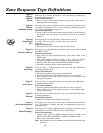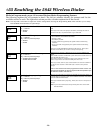
–20–
Data Field Descriptions
✻50
15-Second Dialer Delay (Burglary)
0 = no dialer delay
1 = provide 15-second delay of burglary alarm report
when armed away
If enabled, provides communication delay to the central station and allows
the subscriber time to avoid a false alarm transmission. Delay does not
apply to zone type 6, 7, 8, and 9 alarms, which are always sent as soon as
they occur. UL installations: must be 0 (no delay)
✻51
Periodic Test Report
0 = no test report 2 = weekly
1 = once every 24 hrs 3 = once every 30 days
Test report code entered in field
✻
64 is sent.
✻52
First test Report Offset
0 = 24 hrs after exit program mode or download
1 = 6 hours after exit program mode or download
2 = 12 hrs after exit program mode or download
3 = 18 hrs after exit program mode or download
This is the time to first report from programming or downloading.
✻53
Sescoa/Radionics Select
0 = Radionics (0–9, B–F reporting)
1 = SESCOA (0–9 only reporting)
Select 0 for all other formats.
✻
54
Lack of Usage Notification
0 = Disabled 4 = 90 days
1 = 1 day 5 = 180 days
2 = 7 days 6 = 365 days
3 = 27 days
Note: There will be no local annunciation indicating that
this report has been sent to the Central Station.
If enabled, notifies the central station if an end user is not operating their
security system by sending a System Inactivity report 654. The report will
be sent only to the Primary phone number and only if Contact ID® format
was selected.
Note: The report will follow the
✻
49 = 0 rules, no matter which selection
was made in
✻
49.
✻58
RF Jam Detection
0 = no jam detection
1 = RF jam detection with event logging, but no
central station report
2 = RF jam detection with event logging and with
central station report (if trouble/restore report is
enabled in fields ✻60, ✻71)
For Event Logging, Option 2 must be selected.
If the control detects an RF jam condition, a “FAULT” message appears for
zone 90. The Contact ID® code for RF Jam is 344.
Note: This feature cannot be used in conjunction with the 5827 wireless
keypad.
SYSTEM STATUS AND RESTORE REPORT CODES PROGRAMMING (
✻
59 –
✻
76, &
✻
89)
Program Report Codes using the interactive
✻
56 Enhanced Zone Programming Mode, or codes can be entered in data
fields
✻
59-
✻
76,
✻
89. The following is a set of guidelines when programming report codes. The actual report code digits
that you enter depend upon the particular installation, and should be in agreement with you and the central station
office receiving the signals.
With a 3+1 or 4+1 Standard Format: Enter a code in the first box: 1–9, A, B, C, D, E, or F. Enter "#+10" for A
(reports a “0” on some receivers), "#+11" for B, "#+12" for C, "#+13" for D, "#+14" for E, "#+15" for F. Entering "0" in the
first box will disable a report. Entering "0" in the second box results in automatic advance to the next field.
With an Expanded or 4+2 Format: Enter codes in both boxes (1st and 2nd digits) for 1–9, or A–F, as described above.
Entering "0" in the first box will disable a report. Entering "0" in the second box will eliminate the expanded message for
that report.
With ADEMCO Contact ID® Reporting: Enter a digit in the first box to enable the zone to report. Use a different
digit for each zone until you have used up available digits. If the number of zones exceeds the number of available
digits, begin with digit 1 again. This is an "enabling" code only and is not the actual code sent to the central station
office. Entries in the second boxes will be ignored. For system status (non-alarm) codes, enter a “1” in the first box for all
the system conditions you want to send to the central station. A "0" in the first box disables the report.


















